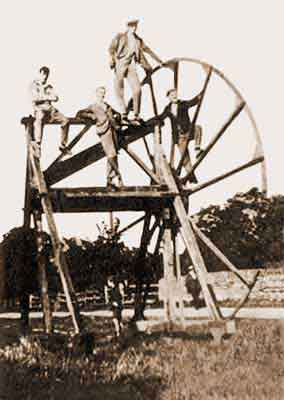
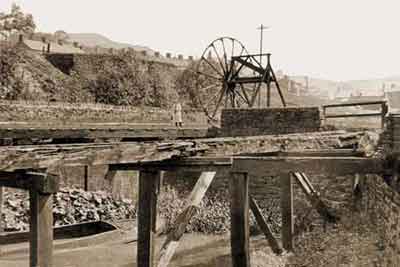
The mobile waggon tipplers and their associated piers were one of the most notable features of Bugsworth Basin at the head of the Peak Forest Canal. The purpose of a tippler was to hoist a mineral waggon loaded with broken limestone and then tip the contents onto the wharf below. From there, the stone was shovelled into a boat. There were four waggon piers but only three of them were fitted with a tippler:
Each pier was raised above its wharf and it was comprised of row of timber stanchions along the wharf edge, which supported beams that were éncastre anchored into the top of the revetment at the back of the wharf. The putlog holes in the revetments that anchored these beams are still extant. Laid along the top of the beams were four baulks of timber that supported the waggon-tippler and mineral-waggon rails. The timber used in the construction of the piers was pitch pine.
The outer pair of timber baulks held the flat-bottomed tippler rails, which was set to a gauge of 7 feet 4 inches, and the inner pair held the L-section rails for the mineral waggons, which were set to a gauge of 4 feet 2 inches.
The tippler was constructed of pitch pine and it consisted of two 'A' frames, each with a vertical centre post that held the iron chain barrel. The revetment end of this barrel was extended to hold a 16-spoke wheel that was 14 feet in diameter. Each 'A' frame was fastened onto 9-inch deep chassis mounted on double-flanged wheels at each end. The axis of the chain barrel was about 7 feet 6 inches above the timber baulks supporting the rails. Two lifting chains, each furnished with a hook, were attached to the barrel, so that they could be attached to a waggon. In effect, a mobile waggon tippler could be likened to a capstan or wheel and axle winch.
Mobile Waggon Tippler & Pier
Drawings based on the tippler on the Upper Basin North Wharf.
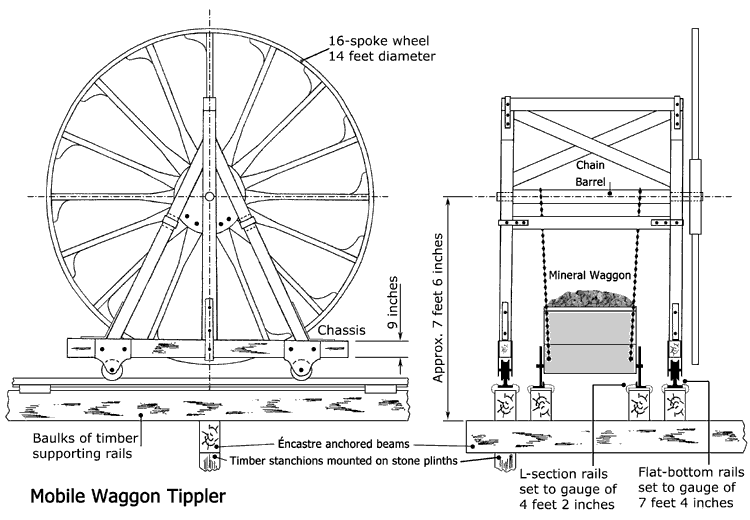
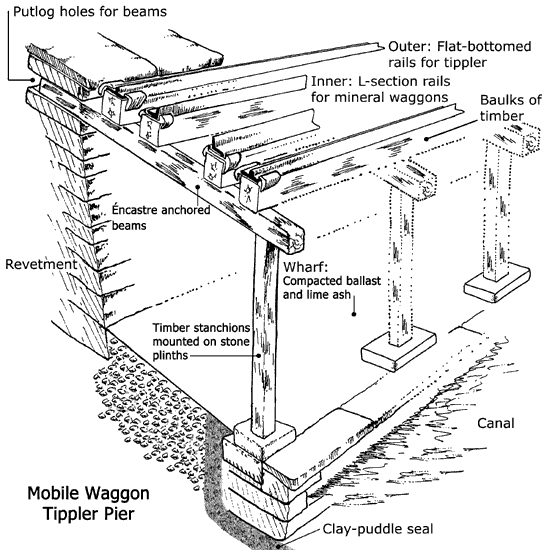
In use, a tippler would be pushed to the end of the pier and then a gang of loaded waggons brought down the Peak Forest Tramway from Dove Holes would be manoeuvred onto the pier. The operator would then position the tippler over the first waggon to be emptied. The end gate of the waggon was removed and the two lifting chains on the barrel were then hooked onto eyes on each corner of the chassis at the other end of the waggon. When everything was ready, the operator climbed onto a convenient spoke of the wheel, using his weight to turn it. This raised one end of the waggon causing the stone to fall between the rails onto the wharf below. In this procedure, the waggon was raised to an angle of around 35 to 40°. Once the waggon was empty, it was lowered back onto the rails and the end gate was replaced. The tippler was then pushed to the next waggon in the gang, where the process was repeated and so on until every waggon in the gang had been emptied.
An examination of photographs indicates that the tippler was not fitted with a locking device to hold it in place while a waggon was emptied, the combined dead weight of the tippler, waggon and stone being relied upon to keep everything steady.
 |
 |
| Waggon Tippler, Lower Basin North Wharf (New Drop), c.1927. | Waggon Tippler, Lower Basin North Wharf (New Drop), c.1927. The abandoned boat in the left foreground is 'Winnie'. |
It is understood that the first of these waggon tipplers were installed at Bugsworth Basin in 1833 and one, at least, was in use until c.1920. There is no known photograph of the tippler on the Middle Basin North Pier and it is presumed that this was the first to fall into disuse and be removed. The tippler on the Upper Basin South Wharf followed this into disuse and removal, leaving the tipplers on the Upper Basin North Wharf and Lower Basin North Wharf. Both of these were still extant when the Peak Forest Tramway was legally abandoned in 1925.
It seems that this type of mobile waggon tippler was unique to Bugsworth Basin and after the last two were scrapped in 1928-29, no remains were kept for future study or exhibition and now only photographs exist to show what they looked like.
 | 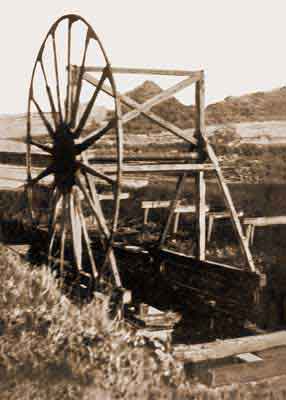 |
| Waggon Tippler, Lower Basin North Wharf (New Drop), c.1927. The two ladies are, left to right, Ethel Brown and Lily Kirkham. | Waggon Tippler, Upper Basin North Wharf, c.1927. |
Contemporary descriptions of the tipplers
Farey wrote, not very accurately:
···· by means of a movable Crane and Tippling Machine which runs on an outer Railway laid on purpose behind that on which loaded trams approach the sides of the boats. A man by means of a Winch-handle and chain which he fastens to the head of the tram, first turned round, on a turning plate, with its tail towards the Boat, shoots out its content.
Mr R Rawlinson of Whaley Bridge wrote, quite accurately:
I worked at Bugsworth at one period, and many times watched the waggons rattling down the track loaded with lime (limestone and lime), but it was the tipping into boats that interested me (onto the wharf, not into the boat). They had a Heath-Robinson contraption in the shape of a gigantic wooden wheel, which turned a wooden centre capstan (the chain barrel was made of iron). Two iron chains were attached from the capstan (barrel) to two corners of the waggon chassis, and as the wheel was manually turned it wound the chain round the capstan (barrel), gradually lifting one end of the waggon until it shot its contents into the boat beneath (actually onto the wharf beneath). Then the weight of the waggon descending spun the wheel in the opposite direction, and the method of stopping it was for the man to grab one of the spokes as it spun. You can imagine how breath-taking it was as he shot into the air with the wheel's momentum, and almost went over the other side. Then how his own weight descended rapidly to earth.
As Mr Rawlinson was aware of Heath Robinson's contraptions, it is possible to date his description to somewhere between 1900 and 1920.
Reminiscences of Mrs Martha Barnes of Bugsworth in 1969
Another small basin further down canal side opposite the waterfall (Lower Basin opposite the weir on the Black Brook). A big wheel there used to tip up waggons. Operated by John Goddard from Gnat Hole and then Jack Worth from the Bings. Used to climb onto the staves (spokes) to set it in motion and jump on to it (off it) with his (and use his ) hands to stop it.
In the above anecdote Mrs Barnes explains that the operator jumped off the wheel to hold the waggon in the raised position by holding the wheel stationary with his hands. The limestone would then tumble out of the waggon.
Crane (tippler) on rails leading to dead end (Lower Basin) by waterfall (weir) on Black Brook. The rails were on stilts (a pier). Stone tipped from waggon onto platform (wharf) by canal and then shovelled into barges. Big wheel worked by John Worth. One leg shorter than the other. Looks as though he had had polio. Worked the wheel by climbing up the wheel to get it in motion. No broader than a cartwheel: climbed up the spokes. Used to climb up the spokes of the wheel till the waggon tipped up. Chains fastened to closed end of the waggon. The other end opened up so that the limestone would fall out (that is, the end gate was removed). Stone tipped onto platform (wharf) by the canal. John Worth also worked the wheel in front of the Navigation (Upper Basin North Wharf).
The above John Worth was the eldest son of the John Worth who was the Wharfinger at Bugsworth Basin. It is understood that the last person to operate a tippler was Isaac Worth and it is likely that he was the son of the above John Worth.
Crane (tippler) by loading shed was on wheels running on lines. Was never used for unloading barges (this was not possible). Crusher near there was worked by Jimmy Wightman.
In the above anecdote Mrs Barnes is again referring to the tippler on the Lower Basin North Wharf. The crusher was in the limestone crusher house and it was used to produce ballast for railways.
Limestone thrown out down embankment (revetment at the back of the wharf) by canal bridge (Chinley Road Bridge) by front of Navigation using a wheel on a trolley of four wheels. Hooked it onto one side (end) of waggon. Lifted it up. Let side down (that is, removed the end gate at the other end) and limestone slid out.
In the above anecdote Mrs Barnes is referring to the tippler on the Upper Basin North Wharf.